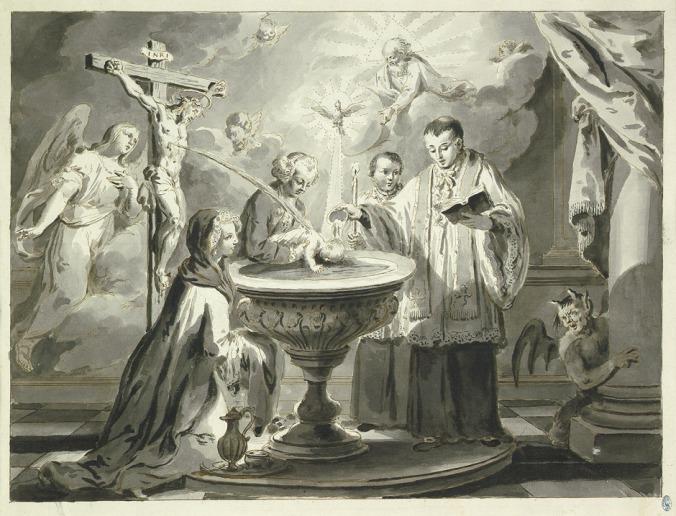I just stumbled across Pietro Antonio Novelli’s engravings on the Seven Sacraments, completed in 1779. They give a fascinating view of ecclesiastical life in the late 18th century – Novelli would have moved to Rome from Venice about this time, so it’s unclear which part of Italy these were drawn from. Either way, they’re worth a look through. All are taken from Wikimedia Commons.

Baptism. Note the prominent Angel and Devil.
Confirmation. Strong and sound emphasis placed upon the role of the Holy Ghost.

The Eucharist. The arrangement of the Altar and rail suggests that this is a low mass. Very odd that the Priest has no chasuble, but surplice and stole.
Penance. Once again, we see the Angel-Devil dichotomy. Lovely open confessional, too.

Holy Orders. It is entirely unclear to me where the Altar is supposed to be in this image. Nevertheless, the Bishop is wearing a wig, which answers a question of Fr. Hunwicke’s.

Holy Matrimony. A fairly straightforward scene with lovely, somewhat spare Neoclassical church architecture in the background.

Unction. The attendance of two servers is a custom long since out of fashion. One rather wonders when their presence was removed from the rubrics.
The image for the Eucharist does not show the mass (low nor high) but the reception of the sacrament outside of mass.
LikeLike
This is itself an intriguing choice. Why *not* depict the Mass? Why go with an exceptional circumstance instead?
LikeLike
It wasn’t exceptional back in those days but the norm.
I would guess the artist chose this scene rather than a scene of Mass because all the rest of the pictures show people in the act of receiving sacraments, not just present at a ritual in which the Sacrament was being performed.
LikeLike
Because properly speaking the Mass is not a Sacrament. Rather, the Mass is the context in which the Sacrament is confected. Even though the catechism of the Catholic Church says that holy mass is one of the names of the sacrament, the truth is that you will almost never find a list of the seven sacraments with “holy mass” been one of them. Wait to clarify this is to notice how we speak about the Eucharist. For example we can say that the Eucharist is reserved in the tabernacle, but it would make absolutely no sense to say that the holy mass is reserved in the tabernacle. We can say the Eucharist is the body and blood of Christ, but not that the mass is the Body and Blood of Christ. We can say that we are going to participate in adoration of the Eucharist, we will never say that we are going to participate in adoration of the holy mass.
LikeLike
Most High Masses on Sundays and Holy Days were non-communicating. Usually they would be followed by the distribution of the Eucharist to a few rare communicants.
LikeLike
In my comment above I meant to say “A way to clarify this” not “wait to clarify this”. My apologies; I was using dictation and did not check it before posting.
LikeLike
Pingback: Another View of the Sacraments in the Eighteenth Century | The Amish Catholic